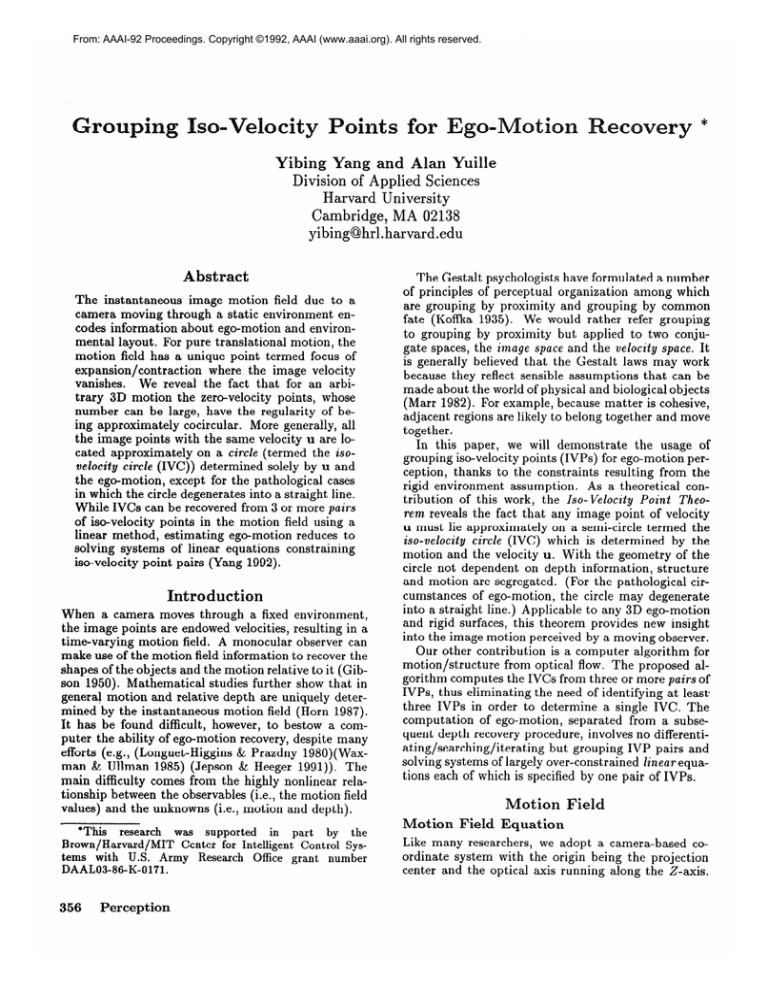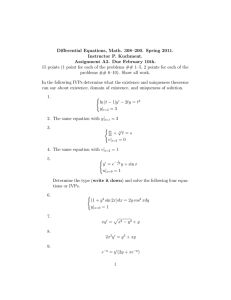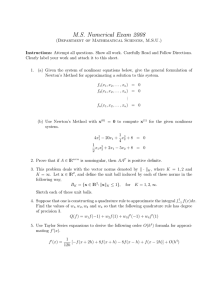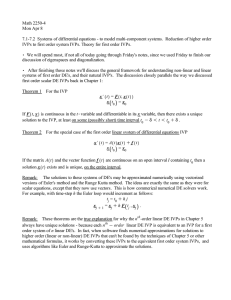
From: AAAI-92 Proceedings. Copyright ©1992, AAAI (www.aaai.org). All rights reserved.
Yibing Yang and Alan Yuille
Division of Applied Sciences
Harvard University
Cambridge, MA 02138
yibing@hrl.harvard.edu
Abstract
The instantaneous image motion field due to a
camera moving through a static environment encodes information about ego-motion and environmental layout. For pure translational motion, the
motion field has a unique point termed focus of
expansion/contraction
where the image velocity
vanishes.
We reveal the fact that for an arbitrary 3D motion the zero-velocity points, whose
number can be large, have the regularity of being approximately cocircular. More generally, all
the image points with the same velocity u are located approximately on a circle (termed the isovelocity circle (IVC)) determined solely by u and
the ego-motion, except for the pathological cases
in which the circle degenerates into a straight line.
While IVCs can be recovered from 3 or more pairs
of iso-velocity points in the motion field using a
linear method, estimating ego-motion reduces to
solving systems of linear equations constraining
iso-velocity point pairs (Yang 1992).
Introduction
When a camera moves through a fixed environment,
the image points are endowed velocities, resulting in a
time-varying motion field. A monocular observer can
make use of the motion field information to recover the
shapes of the objects and the motion relative to it (Gibson 1950). Mathematical studies further show that in
general motion and relative depth are uniquely determined by the instantaneous motion field (Horn 1987).
It has be found difficult, however, to bestow a computer the ability of ego-motion recovery, despite many
efforts (e.g., (Longuet-Higgins & Prazdny 198O)(Waxman & Ullman 1985) (Jepson & Heeger 1991)). The
main difficulty comes from the highly nonlinear relationship between the observables (i.e., the motion field
values) and the unknowns (i.e., motion and depth).
*This research was supported in part by the
Brown/Harvard/MIT Center for Intelligent Control Systems with U.S. Army Research Office grant number
DAAL03-86-K-0171.
356
Perception
The Gestalt psychologists have formulated a number
of principles of perceptual organization among which
are grouping by proximity and grouping by common
fate (Koflka 1935). We would rather refer grouping
to grouping by proximity but applied to two conjugate spaces, the image space and the velocity space. It
is generally believed that the Gestalt laws may work
because they reflect sensible assumptions that can be
made about the world of physical and biological objects
(Marr 1982). For example, because matter is cohesive,
adjacent regions are likely to belong together and move
together.
In this paper, we will demonstrate the usage of
grouping iso-velocity points (IVPs) for ego-motion perception, thanks to the constraints resulting from the
rigid environment assumption. As a theoretical contribution of this work, the Iso-Velocity Point Theorem reveals the fact that any image point of velocity
u must lie approximately on a semi-circle termed the
iso-velocity circle (NC) which is determined by the
motion and the velocity u. With the geometry of the
circle not dependent on depth information, structure
and motion are segregated. (For the pathological circumstances of ego-motion, the circle may degenerate
into a straight line.) Applicable to any 3D ego-motion
and rigid surfaces, this theorem provides new insight
into the image motion perceived by a moving observer.
Our other contribution is a computer algorithm for
motion/structure from optical flow. The proposed algorithm computes the IVCs from three or more pairs of
IVPs, thus eliminating the need of identifying at least.
three IVPs in order to determine a single IVC. The
computation of ego-motion, separated from a subsequent depth recovery procedure, involves no differentiating/searching/iterating
but grouping IVP pairs and
solving systems of largely over-constrained Zineurequations each of which is specified by one pair of IVPs.
Motion Field
Motion
Field Equation
Like many researchers, we adopt a camera-based coordinate system with the origin being the projection
center and the optical axis running along the Z-axis.
Under perspective projection,
a world point P =
(X, Y, Z’)T is imaged at p = (g, y, f>* = ;P, where f
is the focal length. Suppose the camera moves with instantaneous translational velocity t = (tz, t,, tt)T and
rotational velocity r = (Ye:, ry, r,)* relative to a static
environment. Then the induced image velocity at p is
where i is the unit vector in the Z-direction. This is
the well-known motion field equation which specifies
the image velocity Ij as a function of motion {t, r} and
depth 2, as well as the image position p.
To gain more insight into the relation between Ij and
p, we rewrite the motion field equation in the following
form:
MF pers
f -lx
:u =
wherex=(z,y)Tandu=(u,V)T=f-lx.
Ifboththe
translational velocity t and depth Z are magnified or
reduced by the same factor, the motion field remains
unchanged. This scale factor ambiguity shows that the
absolute magnitude of the translational motion is not
encoded in the motion field. Only the relative values
ts/tL, t,/t, and Z/t, take effects, assuming t, # 0.
Suppose the image size is Ii pixels. The objective of
motion recovery is to estimate the 5 motion parameters {t,/t,,
t,/t,, rz, py, rr}, and the K relative depth
values, given the 2K image velocity values {uk, viz}.
Motion
Fields
in A Small
Field of View
The motion field value in eq. (1) is quadratic in x for
constant depth. If the field of view (FOV) is sufficiently
small,l or maxllxll/f < 1 in the image, then the motion field equation can be expressed in the following
simplified form:
MF para
:u =
b/Z
-r
2
rp
b/Z
The above equation holds if world point P is mapped to
the image point p under the so-called puruperspective
projection (Ohta et al. 1981)(Aloimonos 1988) which is
an approximation of perspective projection under the
condition of small FOV.
Note that if we further assume lateral translation,
i.e., t, = 0, then we get the motion field equation under
‘The visual information within a small FOV is of particular importance. The human eye has much better resolution near the optical axis. It has a high-resolution fovea
where over a lo range the resolution is better by an order
of magnitude than that in the periphery.
orthographic
projection:
MF,,th
:u =
by - b/Z - ry
-rzx
- t,/Z
+ r,
>
(3)
This motion field is ambiguous (up to scale); different motion/structures can give rise to the same motion field. Indeed, if rz:, ry, Z are replaced by rk =
rz + cty , r; = rY - ct,, Z’ = (c + l/Z)-l,
(c = const.)
respectively, then MF,,th remains unchanged. In this
case, it is well understood that motion/structure can
be recovered from the position information of features
at three or more time instants (Ullman 1979).
Fixed Points on Image
A well-known fact concerning the pure translational
motion is the existence of a unique image point called
the focus of expansion/contraction
(FOE) where the
image velocity vanishes. Viewing MFpers as an autonomous differential equation system, we expect more
than one fixed points in the general case that 1: # 0.
Local analysis has shown the fixed points contain useful
information about the ego-motion (Verri et al. 1989).
What we are going to explore in this paper is the global
regularity of the fixed points.
Let us consider the fixed points of MFpara, categorizing them (Jordan 1987) in the extreme cases. When
Z --, 00, we have
u -
(rzy/f
- ry, -rzx/f
+ rz)T
The motion field looks as if it were induced by pure
rotation, It has a unique fixed point x = g+w=y)*,
which is obviously a center.
On the other hand, as Z + 0, we have
u -
&x/f
- WzYlf
- t,y
In this case, the rotational effects are negligible and
the unique fixed point is a node x = E(&, t,)T, corresponding to the direction of translation. At any image
position, the image velocity points to this node.
Definition. The point N k (tz, ty)T f/tz on the
image plane is called the node of translation and the
point C !? h
QTf lrt ? the center of rotation.
As a matter of fact, the node of translation has
the same definition as the FOE. We deem it necessary to give a new name in order to avoid confusion,
because conventionally the latter is used only in the
context of pure translation. The center of rotation is
the rotational counterpart of the FOE which has been
largely overlooked in the computer vision community.
Although C by itself is linked to the trivial case of
pure rotational motion, the alliance of C with N will
prove very useful for characterizing general motion, as
illustrated below.
Theorem
1. All fixed points of MFpara lie exclusively on one of the two semi-circles defined by N and
C.
Yang and Yuille
357
Proof. The key to the proof is
in eq. (Z), matrix + specifies a
x + iY, IJ = u + iv be the complex
and U, respectively. Then eq.- (2)
the observation that
similitude.
Let < =
representations of x
can be rewritten as
p = (t%/z-ir,)f-l~-t,/Z-r,+i(-t,/Z+r,)
(4)
Let /..J= 0 and then the fixed point is
&)
-
=
(tx + it,) + (CJ- ir”)Zf
t, - ir, Z
Notice that the depth 2 takes values on the real axis
(of the complex plane) only and 2 is mapped to i by
a bilinear transformation
which maps a straight line
to a circle biuniformly. When 2 changes from 0 to
00, i changes accordingly from <N = (& + ;tY)f/tz to
tc = (TX + &Ml T, on a circle which has a diameter
specified by [N and tC. Clearly, [N and tC are the
complex representations
ho-Velocity
IlCw- Cull = II+,
Points Theorem
Circles
We shall show that all the IVPs of MFpers are approximately co-circular and all the IVPs of MFpora are exactly co-circular. Here an important question that has
to be answered is how good the approximation is.
Theorem 2. (Iso-Velocity Points Theorem: Nondegenerate case). All the IVPs Xu = (x : u(x) =
u, llxll/f 5 7) of MFpers are nearly co-circular in the
sense that for any x E Zu, there is a point Cu,x
within the circle centered at Cu = C + (-v, u)* f/r,
with
8 = 2
angle radius
with respect~t~~(asnudchcthat
x spans the right
u,x (see Fig. 1).
Proof Eq. (1) can be rewritten as
u = -tx/z
V =-tY/Z+rS-
- ry +t,z/(Zf)
r.zx/f
+ w//f + 6
+ tJ Yl(Zf)
(5)
+ v”
(6)
where (5, G)* = fm2 XX* ( -rY , rs)T. Algebraic manipulations yield
t,
r,z
x - tzfltz
( y - tyf /t, > = (
-y
+ (r9 + u - G)f/rZ
2 - (Tz - v + qf /rz >
Notice that the LHS can be written as (X-N)t,
and the RHS is perpendicular to (x - Cu,x),
G.l,x =
kX- v + G)f/b
(ry + u - iif/rz
/(rdZ)
where
-gq
= jlf$xx*(-r,,
t
(x - N) -L (x - Cu,x)
Perception
rzy]l
This completes the proof.
As illustrated in Fig. 1, the IVPs are located approximately on a circle defined by N and CU. The former
is independent of u and the latter is not. The circle
is centered at MU = (N + Cu)/2 and has a radius
Ru = IlN - C,ll/2.
We denote the IVC as {N, Cu}
or {Wdh}.
Theorem 2 shows that the relative uncertainty of Cpx
has an upper bound proportional to the square of the
FOV value (i.e., maxIIxll/f) and the magnitude of the
center of rotation. Therefore, the uncertainty of both
the center and the radius of the IVC is ~2~~C~~/2.
Points
on the Iso-Velocity
Circle
Since eq. (2) corresponds to G = G = 0 in eqs. (5) and
(6), the IVPs of MFpara lie exactly on the IVC . For
ease of discussion, we now concentrate on the study of
the behavior of the IVPs of MFpara rather than those
of MFpers.
Exactly speaking, the IVPs can be located on only
half of the circle, specified by N and Cu, because of
the positive-definiteness of depth 2. Let xu denote an
image point with velocity u. The position of xu on the
IVC (N, Cu} encodes the depth information Z(xu).
Theorem 3. If at image position xu the image
velocity of MFpara is u and the depth value is 2, then
on the IVC {MU, Ru} the angular position of xu is
LxuMuN = 2arctan2(t, /Z, Pi).
Proof. We know that eq. (2) can be written as eq.
(4 Or
Hence we have
358
From eq. (7) we get
of N and C, respectively.
Inspired by the regularity obeyed by the fixed points,
we proceed to investigate the iso-velocity points (IVPs)
of an arbitrary velocity. Roughly speaking, the relation
between a fixed point and an IVP is like the relation
between a zero-crossing and a level-crossing.
Iso-Velocity
Figure 1: The iso-velocity circle.
( = (tx + ity) + (rp + u - i(rx - v))Z f
t, - ir, Z
Without loss of generality, we assume vector CUN
points to the positive direction of the x-axis.
(We
can always achieve this configuration by rotating the
viewer-based coordinate system around the optical
axis.) Let N = B + C + iA and Cu = B - C + iA,
where C > 0. Then the above equation reduces to
before, orthographic projection corresponds to paraHence
perspective projection plus lateral translation.
the iso-velocity points of MF,,.th are (exactly) collinear
and the IVLs are perpendicular to the translational direction.
~ = iA + (B + C,:% - ii~~- C)rzZ
t%
To gain some empirical understanding, we solve the
motion field equation for a sequence of depth values.
Without loss of generality we assume$’ = 1. For mo, the IVCs intion t = (2,O,lO)*,r = (-3, -5,10)
tersect at N = (.2, O)T. The three IVCs shown in
Fig. 2 (left) correspond to different velocities ~11 =
= (8, -l)*.
For each and ev(wqT,U2
= (4,l)*,w
ery velocity uj, we compute a set of image positions
% = (xj,k) corresponding to Zk = tz/rZ tan&/2,
where 01~= /en/lo, X: = -9, -8,. . . ,8,9,10,
by solvingeq. (1). (Somewhat remarkably, the solution is unique
for each 2.) Points in Xj , j = 1,2,3 are denoted by
0, +, x respectively.
We can see that the quadratic
term in eq: (1) makes the IVPs deviate more or less
from the IVCs. The deviations can hardly be perceived
in the vicinity of the origin. In Fig. 2 (right) we show
the angle Bj,, = Lxj,kMjN VS. depth Zk. Without the
quadratic term in eq. (l), 0 should be an arctangent
function of 2.
Since the IVC is centered at Mu = B + iA we have
L[MUN = L(t - Mu) = L
C(t,
t
+ ir,Z)
.z- ir,Z
Because C is assumed to be positive, the angular position of xu is
LxuMuN
= 2arctan2(t,/Z,
rz)
This completes the proof.
It is worth emphasizing that the angular position of
xu does not change with-u. As 2 increases from 0 to
00, xu(Z) moves% the counterclockwise (clockwise)
direction from N to Cu if t, and rz have the same (opposite) sign. When 2 is small, 0 changes linearly with
2; as 2 becomes bigger, 8 gradually approaches the
saturation value r. As a result, the angular variation
of xu does not depend solely on the depth variation.
Obviously, the co-circular property is a necessary
condition and does not mean-that points on the 1%
have the same velocity. Suppose x is a point on the
IVC (N, C,} with angular position ~9,then u(x) = Q
only if Z(x) = t, tan O/r,. For this reason, it is possible
that no point on {N, C,} has image velocity u(x) = LY.
Especially, the motion field can have no fixed points.
Degenerate
Cases
Numerical
Evaluations
Summary
For a given image velocity, the contributions from motion and depth can be segregated; motion determines
the circle which is the set of feasible image positions
having that velocity and depth affects the relative position on that circle. Our results obtained so far are
illustrated in the following diagram where the gray arrow implies approximation
Up to now we have assumed that tzro # 0; otherwise
the IVC does not exist. Here we discuss the degenerate
cases where either tt or rz vanishes.
Theorem
4. (Iso-Velocity Points Theorem: Degenerate cases). (A) If rz = 0, t, # 0, then all the IVPs
xu = {x : u(x) = u, x/f 5 7) of MFpers lie approximately on the straight line passing through N with
the-sense that for any
direction cIU = u - (GY,-r,)*-in
x E Xu, there is a point du,x, lldu,x - dull 5 ~~ljrll,
such that the triple points N, N+du,x, x are collinear.
(B) If t, = 0, r, # 0, then all the IVPs Xu = (x :
u(x) = u, llxll/f 5 r} of MFpers lie approximately
on the straight line passing through Cu with direction
d = (-ty , t,)* in the sense that for any x E Xu, there
is a point Cu,x, (ICu,x - Cull 5 ~~IlCll, such that the
triple points Cu,x, Cu,x + d, x are collinear.
Proof Similar to that of Theorem 2.
For a 3D motion with either lateral translation or
lateral rotation, the IVC degenerates to the iso-velocity
line (IVL). When rt = 0 the IVLs intersect at N; when
t, = 0 the IVLs are perpendicular to t. As indicated
iso-velocity points
Ego-Motion
The recovery of ego-motion/structure from noisy measurements of motion field is an important problems in
machine vision which has been intensively studied in
the past two decades. Thanks to the Iso-Velocity Point
Theorem, the task can be accomplished by first estimating the five motion parameters N, r. We will show
two important results: (A) the IVCs can be estimated
from pairs of IVPs and (B) the problem of ego-motion
recovery reduces to solving two systems of linear equations.
Yang and Yuille
359
Computing
WCs
An IVC can be estimated from a set of three or more
IVPs. Problem arises when the motion field may have
only pairs of IVPs or in other words, there may only
be two-fold overlapping in the velocity space (see Fig.
3 (upper-right) for an appreciation of the uv-space).
As a matter of fact, the IVCs can be computed from
(three or more) pairs of IVPs. Let u’ = (-v, u)*, X =
f/(2rd).
The center of an IVC can be written as (see
Fig. 1j Mu = M+ Xul , where X and M = (Ad,, My)*
are to be solved. Suppose xu = (x, y)* and x& are a
pair of IVPs and jzu = (xu + xu’)/2. Then we have
MUTherefore
Zulxu
- XL
the inner product of LHS and RHS is zero:
Mx - Av - (x + q/a
( My + Au - (y + !/j/2
).(
Aloimonos, J. 1988.
= h
(8)
Ego-Motion
After been solved for, M and X may be used to compute N and C. The idea is to remove the motion
field component
induced by camera rod1 which is now
known. By virtues of Theorem 4, the resulting motion field have IVPs collinear with the node of translation. By estimating the intersection of (two or more)
straight lines passing through pairs of IVPs we can locate N. Then we can solve for r easily, noting that
C=2M-N.
Experiments
With the 256 x 256 depth map shown as an intensity
image in Fig. 3 (upper-left), a motion field u = u(x) is
generated for the camera to move at t = (-1, 0, lo)*
and r = (O,l,lO) T. The focal length is 5 times the
image size or FOV=11.42O.
The interior orientation
of the camera is a such that the optical axis passes
through the image center. Each image grid point x is
mapped to u(x) in the velocity space shown in Fig. 3
(upper-right) (note the folding). The IVPs are computed from the manifolds of constant u and constant
v. In Fig. 3 (lower-left), conjugate IVPs are linked by
line segments. We solve for M, X using the LS method
and get M = (-53.54,67.10)*,X
= 60.95 (in cells).
360
Perception
We have seen that the image points with the same
velocity provide useful information for motion perception. The IVPs corresponding to ego-motion can
be distinguished from those corresponding to independently moving objects by taking into account contingency in the image space. While the latter indicate
exterior motion(s), the former can be used for recovering ego-motion in an efficient, stable way.
References
With each pair of IVPs providing such a constraint, M
and X can be solved from at least 3 pairs of IVPs. In
practice, we often have a large number of IVP pairs and
thus we can resort to a Least Squares (ES) estimator
or a robust estimator. In the following we use the LS
method. In order to treat all sample pairs equally, eq.
(8) needs to be normalized before computing pseudoinverse.
Computing
Concluding Remarks
;$)=o
Let w = (X - x’, y - y’, (y - y’ju - (x - x’)v) and
h= f(~” + y2 + x’~ + Y’~). Then we get
w(M~,Iw,J)*
After removing the flow component induced by camera roll, the resulting flowfield has the IVPs shown in
Fig. 3 (lower-right). Clearly the IVLs seem to intersect at a common point. Apply the LS technique again
(in cells). More exand we get N = (-126.85,19.44)*
periments can be found in (Yang 1992).
Cyberbetics.
Shape from texture.
Biological
58:345-360.
Gibson, J.J. 1950. The Perception of the Visual World.
Boston, MA: Houghton Mifflin.
Horn, B.K.P. 1987. Motion fields are hardly ever ambiguous. Int. Journal of Computer Vision. 11259-274.
Jepson, A.D. & Heeger, D.J. 1991. A fast subspace
algorithm for recovering rigid motion. In Proc. IEEE
Workshop on Visual Motion. 124-131. Princeton, NJ.
Jordan, D.W. 1987. Nonlinear Differential
New York: Oxford University Press.
Koffka, K. 1935.
Principles
New York: Harcourt Brace.
of Gestalt
Equations.
Psychology.
Longuet-Higgins, H.C. & Prazdny, K. 1980. The interpretation of a moving retinal image. Proceedings of
the Royal Society
of London
B. 208:385-397.
Maybank, S.J. 1985. The angular velocity associated
with the optical flow field arising from motion though
a rigid environment. Proceedings of the Royal Society
of London A. 401:317-326.
Marr, D. 1982. Vision. San Francisco:
and Co.
W.H. Freeman
Ohta, Y.K., Maenobu, K. & Sakai, T. 1981. Obtaining surface orientation from texels under perspective
projection.
In Proc. Int. Joint Conf. Artif. Intell.
746-75 1. Vancouver, Canada.
Ullman, S. 1979. The Interpretation
Cambridge, MA: MIT Press.
of Visual Motion.
Verri, A., Girosi, F. & Torre, V. 1989. Mathematical
properties of the 2-D motion field: from singular points
to motion parameters, J. Opt. Sot. Amer.
Waxman, A.M. & Ullman, S. 1985. Surface structure
and 3-D motion from image flow: A kinematic analysis.
Int.
Journal
of Robotics Research.
4(3):72-94.
Yang, Y. 1992. Ph.D. diss., Division of Applied Sciences, Harvard Univ. Forthcoming.
150loo50f
‘*,
i:
+
e ‘Y
-02 -
?
\
9,
-0.4 -
‘.*
I
.:+
/ ..i.
.,” ,...!i’
-50 -
1”
:
i
j
*..
0 -“““-
-ml-
‘O
ii e
-HO-
-0.6 -
I.
-0.6
”
-0.4
-02
!.
0
0.2
.
0.4
,I
0.6
-2001
-8
-6
4
-2
0
4
6
I
8
Z
x/f
Figure 2: IVPs and IVCs (left) and angular positions
Figure 3: Computing
2
(right).
the node of translation.
Yang and Yuille
361




